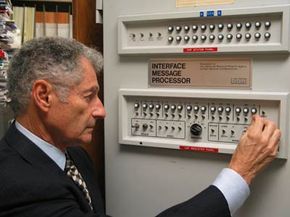How old do you think the Internet is? For most of us, our experience with the Internet dates back to the earliest days of the World Wide Web in the 1990s. But the Internet itself is older than that. It grew from the merger of several individual computer networks -- the oldest and most influential of which was ARPANET.
In 1966, the Advanced Research Projects Agency (ARPA) hosted a program with several research institutions called Resource Sharing Computer Networks. ARPA's goal was to link different computers together, both to increase overall computer power and to decentralize information storage. The U.S. government wanted to find a way to access and distribute information in the case of a catastrophic event, such as a nuclear attack. If a bomb hit an important computer line, information transfers would stop immediately. But if there were a way to network computers, other parts of the system could keep running even if one link were destroyed.
Advertisement
The discussions with ARPA gradually evolved from theory to actual proposals for building these networks. In 1968, ARPA sent out a Request for Quotation (RFQ) to several institutions, asking for bids on creating the first wide area network. Acoustics consulting firm Bolt, Beranek and Newman (BBN) won the bid to design four Interface Message Processors (IMPs), machines that would create open communication between four different computers running on four different operating systems.
The team that designed, built and installed ARPANET was diverse, consisting of electrical engineers, computer scientists, applied mathematicians and graduate students. They recorded their discoveries and processes in a series of documents called Request for Comments (RFCs), which you can find archived along with Internet standards and user information at the Internet RFC/STD/FYI/BCP Archives.
In this article, we'll learn about the equipment used in the original four-node ARPANET. We'll examine the protocols designed to let different computers share information with one another. We'll also look at how the ARPANET team invented many of the Internet functions we take for granted today. Lastly, we'll learn about the end of the ARPANET program.
Advertisement




